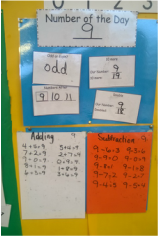
After we completed 4-6 of the 'Number of the Day' task cards (see my previous post if you'd like to download these cards to use in your own class, or you can just click on the pictures above), my kiddos and I used these Addition and Subtraction sheets to come up with all of the addition sums for our 'Number'. So, if our number was 9 (as in the picture), the kids would first give me all of the sums that added up to 9.
I really liked this routine, as I think it developed and strengthened a variety of maths skills and knowledge. At the most basic level, the class was getting daily practice with their number bonds to 10. However, this routine also developed their understanding of how numbers work, so that they were beginning to be able to think strategically about how to solve maths problems.
When the first child gave me 4+5, I'd then ask the next child to 'flip' the addends for me - so they would tell me that if 4+5 = 9, then 5+4 = 9 too. They knew (and it was reinforced frequently) that it didn't matter which number you started with when you added - you always got the same answer. This helped a lot when it came to sums like 4+10...they knew they didn't have to start with the 4, just because it came first!
This routine also developed 'part-part-whole' thinking. Instead of being given 2 numbers and being asked to add them together, the kids were being given the answer. They then had to split it into 2 different groups. Knowing that numbers can be split up in many different ways is such an important skill for developing a variety of mental maths strategies. With this daily routine, the kids were getting lots of practice splitting our Daily Number up in many different ways.
After we found all of the adding sums, we moved to Subtraction. Using the same number (9, in the picture above), the kids gave me all of the subtraction sums that start with the number 9. Again, at a basic level, we were practicing our subtraction bonds to 10. But I think the value of this goes beyond that.
I always did Subtraction AFTER Addition, so that the kids could use the addition sums to help with the subtraction equations. We talked often about how addition and subtraction were opposites - if we start with 4 and add 5 to get up to 9, if we take that 5 away again, we're back at 4. I often used my Learning Resources Base 10 materials to model this on our magnetic white board.
We also 'flipped' our subtraction sums. So when the first child gave me 9 - 6 = 3, I'd ask the next child to give me the matching equation: 9 - 3 = 6. Again, I usually modelled at least one of these using the Base 10 materials - kids need to 'see' what we are doing when we are adding and taking away.
As I move to Primary 3 this coming year, I'll need to modify this a bit, of course, as the kids will be working with larger numbers. If our number is 23, for example, I don't think ALL of the addition and subtraction sums for 23 will fit onto our sheet! But I think that having children come up with 4-5 addition sums (and flipping them), along with 4-5 subtraction sums (and their matching equations), will continue to be an efficient way to help my class develop number sense. I'll let you know how it goes - as I try it out with my class, I'm sure I'll need to adapt my current plans to meet the learning needs I find!



 RSS Feed
RSS Feed